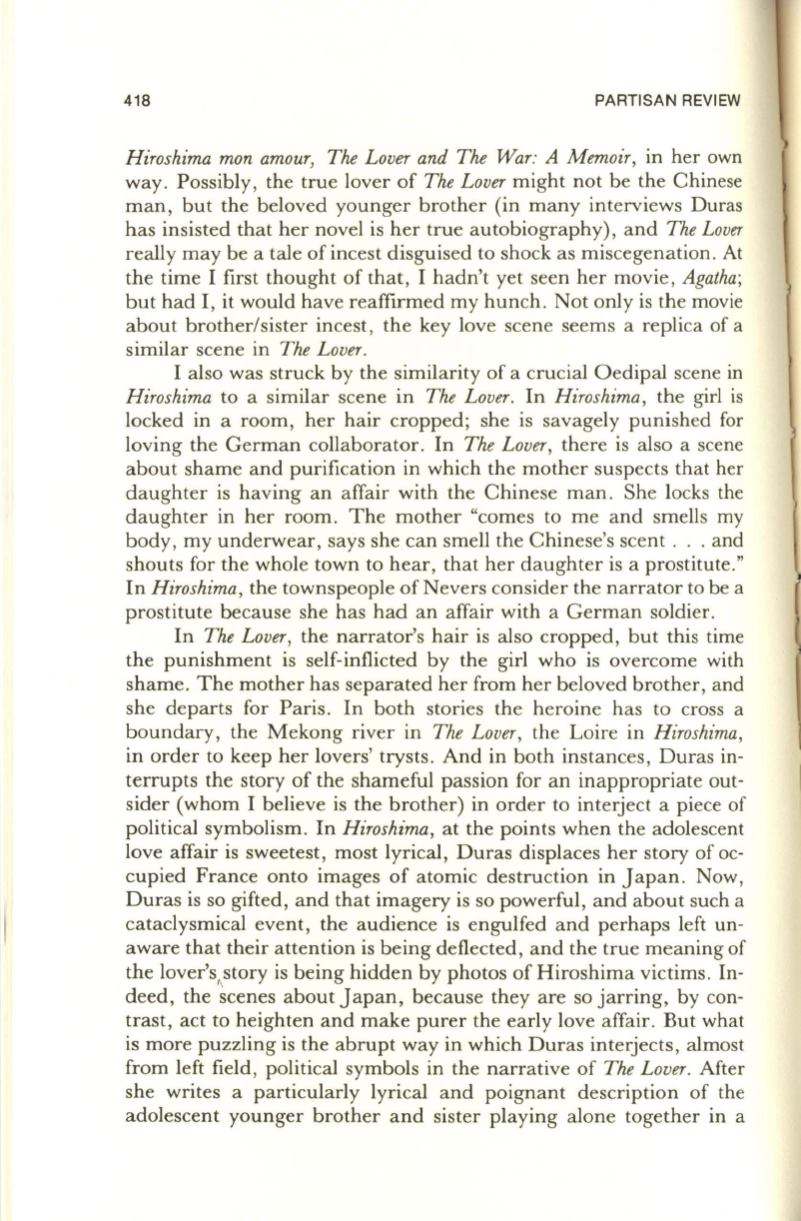
418
PARTISAN REVIEW
Hiroshima mon amour, The Lover and The War: A Memoir,
in her own
way . Possibly, the true lover of
The Lover
might not be the Chinese
man, but the beloved younger brother (in many interviews Duras
has insisted that her novel is her true autobiography), and
The Lover
really may be a tale of incest disguised to shock as miscegenation. At
the time I first thought of that, I hadn't yet seen her movie,
Agatha;
but had
I,
it would have reaffirmed my hunch. Not only is the movie
about brother/sister incest, the key love scene seems a replica of a
similar scene in
The Lover.
I also was struck by the similarity of a crucial Oedipal scene in
Hiroshima
to a similar scene in
The Lover.
In
Hiroshima,
the girl is
locked in a room, her hair cropped; she is savagely punished for
loving the German collaborator. In
The Lover,
there is also a scene
about shame and purification in which the mother suspects that her
daughter is having an affair with the Chinese man . She locks the
daughter in her room. The mother "comes to me and smells my
body, my underwear, says she can smell the Chinese's scent . .. and
shouts for the whole town to hear, that her daughter is a prostitute."
In
Hiroshima,
the townspeople of Nevers consider the narrator to be a
prostitute because she has had an affair with a German soldier.
In
The Lover,
the narrator's hair is also cropped, but this time
the punishment is self-inflicted by the girl who is overcome with
shame . The mother has separated her from her beloved brother, and
she departs for Paris. In both stories the heroine has to cross a
boundary, the Mekong river in
The Lover,
the Loire in
Hiroshima,
in order to keep her lovers' trysts. And in both instances, Duras in–
terrupts the story of the shameful passion for an inappropriate out–
sider (whom I believe is the brother) in order to interject a piece of
political symbolism. In
Hiroshima,
at the points when the adolescent
love affair is sweetest, most lyrical, Duras displaces her story of oc–
cupied France onto images of atomic destruction in Japan. Now,
Duras is so gifted, and that imagery is so powerful, and about such a
cataclysmical event, the audience is engulfed and perhaps left un–
aware that their attention is being deflected, and the true meaning of
the lover\story is being hidden by photos of Hiroshima victims. In–
deed, the scenes about Japan, because they are so jarring, by con–
trast, act to heighten and make purer the early love affair. But what
is more puzzling is the abrupt way in which Duras interjects, almost
from left field, political symbols in the narrative of
The Lover.
Mter
she writes a particularly lyrical and poignant description of the
adolescent younger brother and sister playing alone together in a
I


